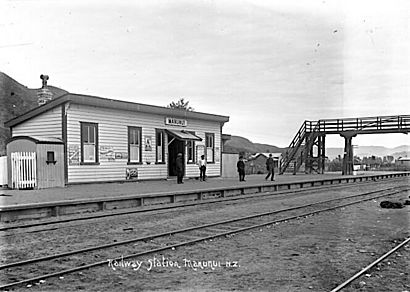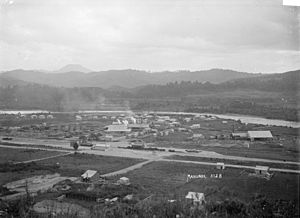Manunui railway station facts for kids
Quick facts for kids
Manunui railway station
|
|||||||||||
|---|---|---|---|---|---|---|---|---|---|---|---|

Railway Station, Manunui between 1904 and 1923
|
|||||||||||
| Location | New Zealand | ||||||||||
| Coordinates | 38°53′28″S 175°19′38″E / 38.8911°S 175.3271°E | ||||||||||
| Elevation | 191 m (627 ft) | ||||||||||
| Line(s) | North Island Main Trunk | ||||||||||
| Distance | Wellington 391.9 km (243.5 mi) | ||||||||||
| History | |||||||||||
| Opened | 2 September 1904 | ||||||||||
| Closed | 31 January 1982 | ||||||||||
| Electrified | June 1988 | ||||||||||
| Services | |||||||||||
|
|||||||||||
The Manunui railway station was an important stop on the North Island Main Trunk line in New Zealand. It served the town of Manunui in the Ruapehu District. This station helped connect the community to the rest of the country. It was mainly used for moving goods and people.
Contents
Manunui Railway Station History
The Manunui station was located about 2.9 kilometers (1.8 miles) south-east of Matapuna. It was also 4.63 kilometers (2.88 miles) north of Piriaka.
Early Days of the Station
Freight services began at Manunui on 2 September 1904. By 16 September 1908, the station had a proper yard, a formed area, and fences. On 10 November 1908, it was officially called a "6th class station."
It included a passenger platform, restrooms, and a way for carts to approach. There was also a goods shed, which was about 9 meters (30 feet) by 6 meters (20 feet), and a loading area. In July 1913, people asked for lighting to be added to the station.
Station Features and Upgrades
The station had a passing loop, which is an extra section of track. This allowed trains to wait while another train passed by. Originally, this loop could hold trains with up to 26 wagons. It was made longer in 1970 to hold 100 wagons. By 1980, it could hold 123 wagons.
Around that time, a company called Caltex had its own siding at the station. This siding could hold 11 wagons. There was also a special store for fertilizer that could hold 15 wagons.
Post Office at the Station
On 6 April 1909, a Post Office opened right at the Manunui station. In May 1911, there was an incident where a safe at the post office was broken into. Later, in October 1911, it was said the Post Office would move from the station. However, in 1912, the local Town Board asked for a stationmaster and postmaster to be appointed. This showed the Post Office was still located at the station.
Signalling and Closure
In 1918, the station's signalling system was updated. It used a "tablet" system to control train movements safely. By 1938, modern colour-light signals were installed. This made it a "switch-out tablet station," meaning the tablet system could be turned off when not needed.
In 1954, two houses for railway workers were built near the station. However, the goods shed closed on 17 February 1978. The entire station officially closed on 31 January 1982, except for handling large loads of goods in wagons. By 22 January 1989, only a concrete block building for equipment remained.
Timber Mills in Manunui
A very large timber mill was built in Manunui by a company called Ellis & Burnand. The area was named Manunui from 24 August 1904. Before that, it was known as Waimarino.
Ellis & Burnand Mill Operations
Logs were brought to the mill using a special tramway that was about 8 kilometers (5 miles) long. This tramway started from a place called Ohotaka. In 1905, a 104-meter (340-foot) bridge was built over the Whanganui River for the tramway.
The main timber mill closed in 1942 and later burned down in 1949. However, the Ellis Veneer works continued operating. Veneer is a thin layer of wood. In 1953, this part of the factory produced about 7 million square feet of plywood. Plywood is a strong board made from thin layers of wood glued together.
Pungapunga Sawmilling Company
From 1911, another company called Pungapunga Sawmilling Co also had a siding at the station. Their siding could hold up to 5 wagons.


